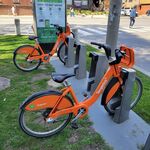M II A II R II K
Senior Member
Pedestrians take to the streets; motorists learn to coexist
By Philip Langdon
Read More: http://newurbannetwork.com/article/pedestrians-take-streets-motorists-learn-coexist-13660
Britain is energetically designing streets that intermingle foot and vehicular traffic; the US follows ever so cautiously. Maybe it’s a reflection of American car culture. Or maybe it’s a sign of how risk-averse the United States has become. Whatever the reason, the US is a long way from catching up to Europe in designing streets that allow the flexible, unchoreographed mixing of cars, trucks, buses, bicycles, and pedestrians.
A recent presentation by Ben Hamilton-Baillie at the Lincoln Institute of Land Policy in Cambridge, Massachusetts, highlighted how far Europe, and especially Great Britain, have gone toward letting motorists and pedestrians sort things out for themselves rather than having traffic engineers impose a strict order on circulation.
The Netherlands pioneered much of Europe’s modern work in “shared-space†streets, under the influence of traffic engineer Hans Monderman. Since Monderman’s death in January 2008, the United Kingdom seems to have taken the lead, thanks in large part to Hamilton-Baillie, whose Bristol, England, firm, Hamilton-Baillie Associates, has designed the UK’s most notable shared street spaces.
Monderman advocated getting rid of the welter of traffic signs, pavement striping, and other devices intended to regulate conflicting modes of traffic. He believed that human beings — whether in motor vehicles, on bikes, or using their own two feet — could intuitively adjust their movement and manage to cross the streets and squares safely.
Monderman operated mainly in small towns, where traffic tended to be light. There it was fairly easy to count on pedestrians and motorists to keep an eye on one another, thus avoiding accidents. By contrast, Hamilton-Baillie has introduced the shared-space idea to streets in the center of a great metropolis — London.
You might think that where motorists are much more hurried and numerous, they would pay less attention to pedestrians. Yet in London and elsewhere in Britain, the results have been encouraging.
....................



By Philip Langdon
Read More: http://newurbannetwork.com/article/pedestrians-take-streets-motorists-learn-coexist-13660
Britain is energetically designing streets that intermingle foot and vehicular traffic; the US follows ever so cautiously. Maybe it’s a reflection of American car culture. Or maybe it’s a sign of how risk-averse the United States has become. Whatever the reason, the US is a long way from catching up to Europe in designing streets that allow the flexible, unchoreographed mixing of cars, trucks, buses, bicycles, and pedestrians.
A recent presentation by Ben Hamilton-Baillie at the Lincoln Institute of Land Policy in Cambridge, Massachusetts, highlighted how far Europe, and especially Great Britain, have gone toward letting motorists and pedestrians sort things out for themselves rather than having traffic engineers impose a strict order on circulation.
The Netherlands pioneered much of Europe’s modern work in “shared-space†streets, under the influence of traffic engineer Hans Monderman. Since Monderman’s death in January 2008, the United Kingdom seems to have taken the lead, thanks in large part to Hamilton-Baillie, whose Bristol, England, firm, Hamilton-Baillie Associates, has designed the UK’s most notable shared street spaces.
Monderman advocated getting rid of the welter of traffic signs, pavement striping, and other devices intended to regulate conflicting modes of traffic. He believed that human beings — whether in motor vehicles, on bikes, or using their own two feet — could intuitively adjust their movement and manage to cross the streets and squares safely.
Monderman operated mainly in small towns, where traffic tended to be light. There it was fairly easy to count on pedestrians and motorists to keep an eye on one another, thus avoiding accidents. By contrast, Hamilton-Baillie has introduced the shared-space idea to streets in the center of a great metropolis — London.
You might think that where motorists are much more hurried and numerous, they would pay less attention to pedestrians. Yet in London and elsewhere in Britain, the results have been encouraging.
....................







